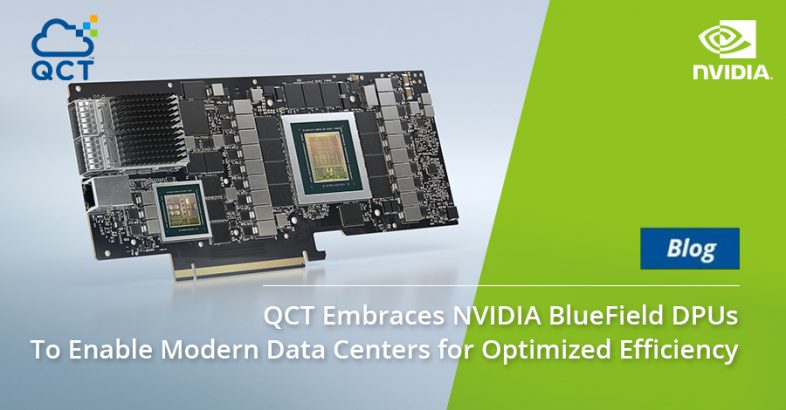We are all familiar with the CPU, or central processing unit, as it has been the heart of every computer since the 1950s. Traditionally it is designed to process a linear stream of data, and in a data center the network is an entanglement of cables, linked by switches to deliver data to and from the CPUs. But the data center is evolving, and at QCT we have been helping a variety of organizations to build modern data centers that need to handle larger compute and storage workloads, which places more stress on CPU cores that have a hard time handling billions of rigorous processing instructions. Although we have had the GPU, or graphics processing unit, a component originally used to deliver rich real-time graphics, to offload CPU tasks with their parallel processing capabilities for the last decade, the CPU still becomes burdened with the amount of data that is shared between computers and concurrently fed to GPUs. Now, for the next generation of data centers we have the NVIDIA BlueField-2 data processing unit (DPU).
What makes the DPU different from CPUs and GPUs is the way it manages how the data is moved through the data center. NVIDIA currently offers its NVIDIA BlueField-2 DPU, which not only offloads critical network, security, and storage tasks from the CPU, but also delivers optimized data processing efficiency because the network is connected through the BlueField-2 DPU. In other words, the right data gets to the right place along the most efficient networking route. BlueField acts as a single piece of silicon, integrating 64-bit Arm multi-core processing power, and is built into a network interface controller (NIC), in what is often called a SmartNIC. As a result, QCT’s QuantaGrid D43K-1U and D52B-1U are able to utilize the NVIDIA BlueField-2 DPU to bring the processing closer to the data itself, as it operates as a co-processor to accelerate specific storage tasks from the host.
With the current pandemic, and the growth of data in various markets becoming critical for everyday tasks, the data center is also quickly becoming widely sought after. Furthermore, when you add cloud-native infrastructures with innovation enabling microservices, specialized components then become the missing link to meet the ever increasing number of users, data, virtualization, and various cloud computing technologies – all of which burden the data center as they also move towards AI and 5G. In order to keep the new data center architecture accelerated and secure on the same infrastructure, QCT will be certifying their QuantaGrid systems via the NVIDIA-Certified systems program to offer NVIDIA EGX Edge AI platforms for modern enterprise workloads.
The NVIDIA EGX Edge AI platform includes systems optimized for running AI along with enterprise infrastructure built to handle high-performance training and inference to process real-time streaming data from trillions of IoT sensors — all supported by a rich AI software ecosystem to create AI and 5G services for smart hospitals, robotic factories, intelligent stores and more. EGX servers from QCT are not only able to deliver flexibility, but can also scale to customer needs for a variety of use cases by applying combinations of PCIe-based GPUs and low-latency NVIDIA network adapters (ConnectX-6, ConnectX-6 Dx, and BlueField-2 DPU). QCT’s existing product lineup, including QuantaGrid server systems D52BV-2U, D43KQ-2U, and D52G-4U, have been validated by NVIDIA, and QCT will be qualifying additional servers through the NVIDIA-Certified systems program with NVIDIA EGX technology in the coming months.
To learn more about GTC 2020, visit https://www.nvidia.com/en-us/gtc/.
Follow QCT on Facebook, Linkedin, and Twitter to receive the latest news and announcements related to servers with NVIDIA BlueField-2 DPU capabilities and technologies that will define the next generation of cloud-scale computing.
QCT Embraces NVIDIA BlueField DPUs to Enable Modern Data Centers for Optimized Efficiency

